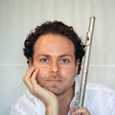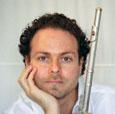I believe that a good performance should first and foremost be an expressive one. It is of no use to be technically perfect if the listeners’ hearts are not moved. Of all the concerts I have heard and played, the only memorable ones were those in which the focus was about music and emotion. When we abandon ourselves to the music, the audience is transported to new realms, and in those magic places we forget the present.
How to be Expressive
Warmth, depth, and honesty in performance must come from the emotions within us. When learning a piece of music, identify the emotional content of all of its passages. Ask what this bit of music is about. Decide whether it is playful, sad, serious, happy, tender, melancholic, painful, sweet, or mysterious.
When we practice without feeling anything and only think about the technicalities of the flute, we cannot express anything, and even worse get used to playing that way. When practicing, always keep in close contact with the content of the music. Let it affect you both emotionally and physically.
As part of your practice routine, incorporate the steps of a method actor. In front of a mirror, portray happiness and then sadness. Try to actually feel emotionally what you are portraying. Notice how your whole body changes, and especially, how your breathing changes. Like actors, learn to feel the emotion you are trying to convey. Instead of seeking clarity of speech, flutists should use articulation and unforced tone projection to create appropriate inflexions.
Another aid to studying emotion in music is to listen to recordings and performances by great singers. They have the benefit of text and are masters at bringing an audience to tears or laughter. Get some opera arias or art songs by composers such as Schubert, Fauré, and others. Study the text and play the tunes. Then portray the appropriate emotion with tone color, nuance, and phrasing while using the flute to sing instead of your voice.
Learn the Architecture of Music
Passion is of no use without architecture. You will not build a house by happily throwing a bunch of bricks together. Music has structure and correct grammatical style. Many times a composer has not provided any expressive markings, you have to find a way to let the expression evolve. Figure out how to show the structure of a piece to listeners.
There is logic to be found in the design of a musical line. Musical interpretation is governed by simple and natural rules that serve to enliven it. Know where a phrase ends and where a new one begins. In addition, learn to identify chord progressions, sequences and patterns, accentuate correctly, and give emphasis to the important spots without accenting the less important ones.
In short, you should know the music inside and out. I don’t mean learning only the flute part but the full score, whether it is a sonata, chamber work, concerto, or symphony. Only in the full score can we find the complete information necessary to produce a memorable performance.
Speak Poetry At All Times
You should also learn to exploit all of the flute’s possibilities in order to develop a set of expressive tools that allow a clear and varied interpretation of the music. If you keep the same tone color, volume (mezzo forte or worse, forte!) and vibrato throughout, the audience will be bored to tears. You should not only have a beautiful personal sound, but also clear and expressive articulation, the ability to play in many nuances (piano-shadow, forte-light, and all nuances in between), and a wide palette of colors. When you learn the musical language so well that you can naturally speak poetry at all times, you will be able to deliver a clear and moving musical message.
To practice these expressive tools, Raymond Guiot taught his students to use the second section (Suppleness in the Low Register, page 10) and the third section (Attack and slurring of notes, page 15) from Marcel Moyse’s De la sonorité. He used these exercises to practice those expressive elements that must be mastered by those wanting to be artists on the flute:
• Diverse nuances (Light and shadow, loud and soft, crescendo, diminuendo)
• Intervals
• Resonance
• Articulation
• Punctuation
• Accentuation
The variations below incorporate all of these elements. By combining, mixing them, and creating your own, the number of variations is infinite. In other words, you will gain the tools and be prepared for any musical situation. I call this active practicing. The letters of the variations correspond to the letters in Moyse’s book. Play one variation per letter everyday.
.jpg)
For more active-practicing ideas, take a look at the following Moyse books: 24 Little Melodic Studies avec variations, 25 Little Melodic Studies (Alphonse Leduc) and How I stayed in Shape (Marcel Moyse, Schott). They are full of little magical melodies and their variations. The melodies provide an excellent feel for the type of music to practice for expression.
Above all, this is the place to experiment. Don’t be afraid to take musical chances. Give your practice melodies every ounce of energy and emotion you have. This will train you to do the same in performance. Remember, music has a natural life and really, the last thing we want to do is to give a plain, dull, and boring performance.
“Play from the soul, not like a trained bird!” (C.P.E. Bach)






